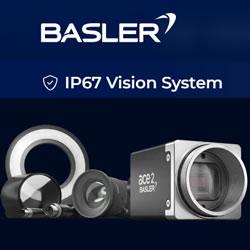ATI Develops New Model Force/Torque Sensor
Mini58 Sensor Offers a Large Measurement Range in a Small Package
ATI Industrial Automation has developed a new Six-Axis Force/Torque Sensor model. Weighing only 0.5 kg with a diameter of only 58 mm, the Mini58 Sensor was developed for a wind tunnel application that required a smaller, more compact sensor with a large measurement range. Despite its small size, the Mini58 is extremely durable, with maximum allowable single-axis overload values that are 4.9 to 21.0 times rated capacities. The Mini58 includes a through-hole to allow passage of linkages or cables and also features a robust cable connection that offers improved strain-relief. Some typical applications for the Mini58 include: humanoid robotics, orthopedic research, biomechanical research, and wind tunnel testing.
ATI's Force/Torque Sensor System measures six components of force and torque (Fx, Fy, Fz, Tx, Ty, Tz) and features a compact design, hardened stainless steel construction, high-speed output, overload protection, span temperature compensation options, and high signal-to-noise ratio. ATI offers a wide range of custom and standard sensor models from 17 mm to 300 mm and include environmental protection (IP) on most models. With over 20 years of robotic end-effector innovation, ATI's engineering department, the largest of its kind for a robotic tooling company, is focused on developing cost-effective, state-of-the-art products and solutions.
Featured Product

